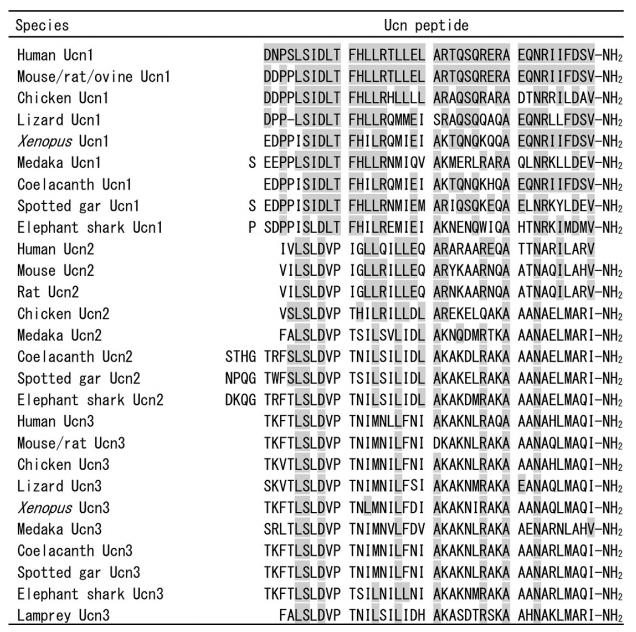| Identification | Back Directory | [Name]
UROCORTIN (HUMAN) | [CAS]
176591-49-4 | [Synonyms]
UCN
urocortin
Human urocortin
Human urocortin 1
Human urocortin I
UROCORTIN (HUMAN)
Urocortin 1 (human)
Urocortin (human) (9CI)
Urocortin huManUrocortin h
Urocortin human, ≥85% (HPLC)
M.W. 4696.29 C204H337N63O64
Urocortin human >=85% (HPLC), powder
UROCORTIN (HUMAN) TRIFLUOROACETATE SALT
Anti-Urocortin, C-Terminal antibody produced in rabbit
ASP-ASN-PRO-SER-LEU-SER-ILE-ASP-LEU-THR-PHE-HIS-LEU-LEU-ARG-THR-LEU-LEU-GLU-LEU-ALA-ARG-THR-GLN-SER-GLN-ARG-GLU-ARG-ALA-GLU-GLN-ASN-ARG-ILE-ILE-PHE-ASP-SER-VAL-NH2
H-Asp-Asn-Pro-Ser-Leu-Ser-Ile-Asp-Leu-Thr-Phe-His-Leu-Leu-Arg-Thr-Leu-Leu-Glu-Leu-Ala-Arg-Thr-Gln-Ser-Gln-ArgGlu-Arg-Ala-Glu-Gln-Asn-Arg-Ile-Ile-Phe-Asp-Ser-Val-NH2
H-ASP-ASN-PRO-SER-LEU-SER-ILE-ASP-LEU-THR-PHE-HIS-LEU-LEU-ARG-THR-LEU-LEU-GLU-LEU-ALA-ARG-THR-GLN-SER-GLN-ARG-GLU-ARG-ALA-GLU-GLN-ASN-ARG-ILE-ILE-PHE-ASP-SER-VAL-NH2 | [Molecular Formula]
C206H338F3N63O66 | [MDL Number]
MFCD00802621 | [MOL File]
176591-49-4.mol | [Molecular Weight]
4810.27 |
| Questions And Answer | Back Directory | [Discovery]
Ucn1 was first reported in 1995 from the rat midbrain as a peptide with higher potency in binding and activating CRHR2 than does CRH.1 Subsequently, using the genome information, two novel CRH-related peptides that showed high affinity to CRHR2, Ucn2 (stresscopin-related peptide) and Ucn3 (stresscopin), have been identified in the mouse and the human/mouse, respectively. Ucns have been reported in several tetrapods such as the chicken, lizard, and Xenopus. It has been reported that genes for Ucn1, 2, and 3 are present in the coelacanth (a lobe-finned fish), spotted gar (a basal ray-finned fish), and elephant shark (a cartilaginous fish). In the sea lamprey, Ucn3 has been cloned. Recently, three Ucns have been cloned from the brain of the medaka. | [Structure]
The Ucn1 of some mammals (human, mouse, rat, ovine), chicken, reptile, and Xenopus as well as Ucn3 consist of 40 aa residues with an amidated C-terminus. The Ucn2 of some mammals, chicken, and medaka consist of 38 aa residues. The sequence identities of the rat Ucn1 peptide with those of the rat/mouse/human CRH, carp urotensin-I (UI), and sauvagine (SVG) are 45%, 63%, and 35%, respectively. The sequence identities of medaka Ucn1, Ucn2, and Ucn3 peptides with those of their mammalian counterparts are 50%–52%, 39%, and 70%, respectively. Human Ucn1 (Mr 4696; pI 5.1) is soluble in water. Human Ucn2 (Mr 4138; pI 11.4) and Ucn3 (Mr 4368; pI 10.3) are insoluble in water and soluble in DMSO.
 | [Biological functions]
Ucn1 stimulates adrenocorticotropic hormone (ACTH) secretion both in vivo and in vitro while Ucn2 and Ucn3 do not stimulate ACTH secretion. This effect of Ucn1 on the pituitary is probably mediated by CRHR1, as is CRH. Ucn1 is more potent than CRH in suppressing food intake. Ucn-specific effects are considered to be mediated by CRHR2. ICV injection of Ucn1 increases whole body oxygen consumption and body temperature in the rat. Ucn1 has been reported to participate in vascular inflammation, and to function as an anxiolytic in stress response. Ucn2 and Ucn3 may be responsible for the effects of stress on appetite and anxiety in the brain. Ucn2 blocks the suppression of gastric antral contractions induced by lipopolysaccharide in freely moving conscious rats. | [Receptors]
Ucns act through CRHR2. Ucn1 also binds to the type 1 CRH receptor (CRHR1), whereas Ucn2 and Ucn3 bind exclusively to CRHR2. Ucn1 is considered to act mainly through both Gαs and Gαq subunits to stimulate diverse signaling cascades such as AC and PLC pathways, depending on the tissue type. | [Synthesis and release]
Ucns are synthesized as large precursors, which are cleaved to yield the active mature peptides. The human Ucn1 gene, UCN1, location 2p23–p21, consists of two exons and one intron. PreproUcns are encoded in the second exon. UCN2 is located on human chromosome 3p21.3 and on mouse chromosome 9 while UCN3 is located on human chromosome 10p15.1 and on mouse chromosome 5. Mature Ucn peptides are coded by the C-terminal of the precursor, and basic amino acid residues exist in the N-terminal of the mature peptide for processing. In the Ucn1 precursor, consecutive basic amino acids (Arg-X-Arg-Arg) exist, and Ucn1 is processed from the prohormone by endopeptidase. A dipeptide Gly-Lys is present in the C-terminal region of the mature peptide. The C-terminal lysine residue is cleaved off by an exopeptidase while the glycine residue is used as an amidation donor. In the precursor of Ucn2 and Ucn3, mature peptides are processed by arginine or lysine located in the N-terminal, and the amidation of the mature peptide occurs after the cleavage of C-terminal arginine or lysine with an exopeptidase. Ucn1 mRNA in the rat thymus is upregulated under stress conditions. Ucn1 mRNA in the mouse Edinger�Westphal nucleus is upregulated by stress and CRH deficiency.
|
| Hazard Information | Back Directory | [Uses]
Urocortin human can be used as a test compound for studying the impact of corticotropin-releasing factor (CRF) receptor agonist and antagonist on sleep-wake patterns in conscious rats by using radiotelemetry system. | [Biochem/physiol Actions]
Urocortin is a CRF-related neuropeptide having high affinity for CRF2 receptor possess appetite-suppressing effect. Urocortin along with corticotropin-releasing factor (CRF) binding protein (CRF-BP) enhances the free CRF levels in human brain by displacing hCRF from the binding protein. | [Clinical Use]
Ucn1 levels are high in the synovial fluid of patients with rheumatoid arthritis. Ucn1 has been linked to a reduction in inflammation and bone erosion in a mouse model of rheumatoid arthritis. | [storage]
Store at -20°C |
|
|